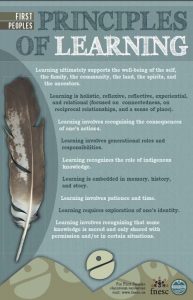Another perspective that I wanted to explore in my topic of Indigenous-Immigrant education was about indigenous students learning about different immigrant cultures. I couldn’t find any sources about any in-depth look into it, so I asked a family friend from the Albany First Nation from Ontario a few questions about it. Below, I’ve included my questions and have summarized his answers in a way that he agrees represents his answers.
Q: “How important is it for indigenous students to learn about immigrant groups as well?”
A: “It’s immensely important in my opinion for indigenous students to not learn solely about themselves. While much of Canadian history has sought to strip away their identities and knowledge, and they should learn about themselves as an overall priority, they should also be learning about those coming into the country. In the same way that we want to avoid cultural normativity between white Canadians and indigenous Peoples, ignoring the many other cultures of new immigrants sets the same precedent that “they should only learn about us.”
Q: What effect do you think that it would have for indigenous students to learn more about immigrants coming into Canada?
A: “Indigenous Peoples are widely welcoming and accepting of new immigrants anyways, but learning about different histories and cultures could make some change their approach in their welcomes. For example, if a particular immigrant population has historically had violent or otherwise tumultuous relations with another ethnic group that claimed stewardship of the land, then they would perhaps perceive us differently than another immigrant group might. It’s all about being open-minded about the experiences of others as well.
Q: Do you think that indigenous students not learning enough about immigrant populations is a reason for the apparent disconnect between the two groups within Canada?
A: “Not at all, the main reason still boils down to the colonial education system and overall anti-indigenous social framework into which immigrants are entering. Immigrants are primarily being greeted and initially supported by either other immigrants, or by white Canadians. Any prejudice or apathy regarding Indigenous Peoples is simply a learned position that they’ve picked up on from their environment. It’s also not our responsibility to be the welcoming committee for new immigrants and to be the ones to build that bridge. Neither of us are at fault here, and the main focus should be the decolonization of Canadian structures.
I found this interview to be quite interesting. I initially thought of the question about Indigenous students learning about immigrant groups as more of a “devil’s advocate” type idea, and I didn’t expect my Indigenous friend to agree at all. His concluding point about decolonization is a great foundation for my argument about bridging the gap between the two groups.




